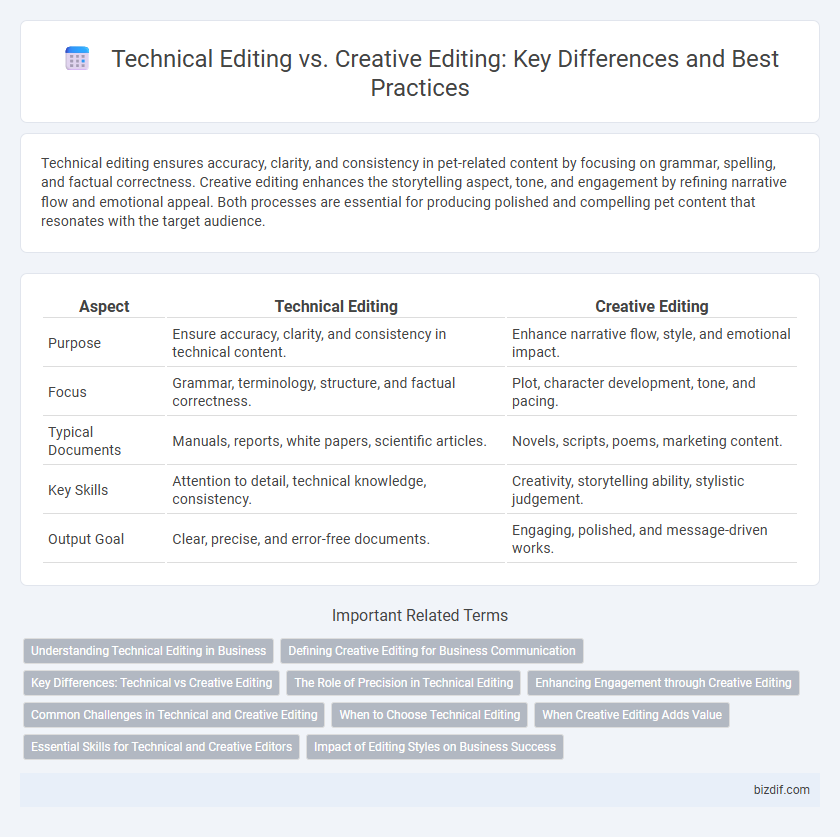Technical editing ensures accuracy, clarity, and consistency in pet-related content by focusing on grammar, spelling, and factual correctness. Creative editing enhances the storytelling aspect, tone, and engagement by refining narrative flow and emotional appeal. Both processes are essential for producing polished and compelling pet content that resonates with the target audience.
Table of Comparison
| Aspect | Technical Editing | Creative Editing |
|---|---|---|
| Purpose | Ensure accuracy, clarity, and consistency in technical content. | Enhance narrative flow, style, and emotional impact. |
| Focus | Grammar, terminology, structure, and factual correctness. | Plot, character development, tone, and pacing. |
| Typical Documents | Manuals, reports, white papers, scientific articles. | Novels, scripts, poems, marketing content. |
| Key Skills | Attention to detail, technical knowledge, consistency. | Creativity, storytelling ability, stylistic judgement. |
| Output Goal | Clear, precise, and error-free documents. | Engaging, polished, and message-driven works. |
Understanding Technical Editing in Business
Technical editing in business involves refining documentation to ensure clarity, accuracy, and consistency of complex information, which is crucial for maintaining professional standards and facilitating effective communication. It focuses on simplifying jargon, verifying facts, and structuring content to enhance usability for target audiences such as clients, stakeholders, and employees. This form of editing supports compliance with industry regulations and helps prevent costly misunderstandings in corporate communications.
Defining Creative Editing for Business Communication
Creative editing in business communication involves shaping content to engage the audience through storytelling, tone adjustment, and stylistic enhancements while maintaining clarity and professionalism. It emphasizes narrative flow, brand voice consistency, and emotional appeal to drive effective messaging and audience connection. Unlike technical editing, which prioritizes accuracy and correctness, creative editing focuses on persuasive and impactful communication.
Key Differences: Technical vs Creative Editing
Technical editing focuses on accuracy, clarity, and consistency in specialized content, ensuring that industry-specific terminology and data are correct and well-organized. Creative editing prioritizes narrative flow, character development, and emotional impact, shaping the story's voice and enhancing reader engagement. Key differences lie in technical editing's emphasis on factual precision and structural coherence versus creative editing's focus on artistic expression and storytelling.
The Role of Precision in Technical Editing
Technical editing demands precision to ensure clarity, accuracy, and consistency in specialized content such as manuals, scientific papers, and legal documents. This meticulous attention to detail enhances the reliability and usability of technical materials by correcting errors, refining terminology, and standardizing formats. In contrast to creative editing, which prioritizes narrative flow and stylistic elements, technical editing centers on exactness and unambiguous communication to support effective knowledge transfer.
Enhancing Engagement through Creative Editing
Creative editing enhances engagement by transforming raw content into compelling narratives that captivate audiences through storytelling techniques, emotional tone, and dynamic pacing. Unlike technical editing, which prioritizes accuracy, grammar, and clarity, creative editing emphasizes voice, style, and flow to maintain reader interest and evoke emotional responses. Utilizing tools such as vivid imagery, strategic restructuring, and rhythm variation, creative editors elevate the content's appeal, driving greater reader connection and interaction.
Common Challenges in Technical and Creative Editing
Technical editing often faces challenges such as ensuring accuracy, clarity, and adherence to industry standards, while maintaining complex data integrity. Creative editing struggles with preserving author voice, enhancing narrative flow, and balancing emotional impact without over-polishing. Both require meticulous attention to detail and a deep understanding of the target audience to effectively convey the intended message.
When to Choose Technical Editing
Choose technical editing when accuracy, clarity, and consistency in complex information are paramount, such as in manuals, scientific papers, or legal documents. Technical editing enhances the precision of jargon, format, and data presentation, ensuring the content adheres to industry standards and is easily understood by the target audience. This type of editing is essential for documents requiring strict compliance and error-free communication.
When Creative Editing Adds Value
Creative editing adds value when transforming raw footage into a compelling narrative by enhancing storytelling elements, pacing, and emotional impact. It plays a crucial role in projects such as films, commercials, and branded content, where audience engagement and artistic expression are paramount. Unlike technical editing, which ensures accuracy and consistency, creative editing shapes the message to evoke desired reactions and create memorable experiences.
Essential Skills for Technical and Creative Editors
Technical editors require strong attention to detail, expertise in subject-specific terminology, and the ability to ensure clarity and accuracy in complex information. Creative editors excel in storytelling, narrative flow, and enhancing the emotional impact of content through language and structure. Both rely on exceptional grammar, consistency, and adaptability to their respective content styles for effective editing outcomes.
Impact of Editing Styles on Business Success
Technical editing ensures clarity, accuracy, and consistency in business communications, which builds trust and reduces errors, directly enhancing operational efficiency. Creative editing shapes brand voice and storytelling, driving audience engagement and emotional connection that boost marketing effectiveness and customer loyalty. The strategic integration of both editing styles maximizes content quality, resulting in measurable improvements in brand reputation and revenue growth.
Technical Editing vs Creative Editing Infographic

 bizdif.com
bizdif.com